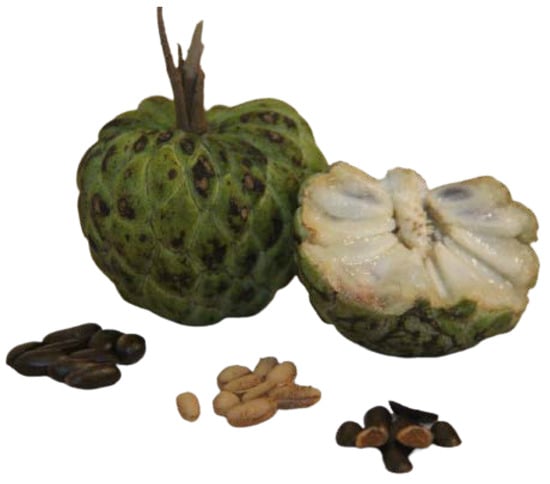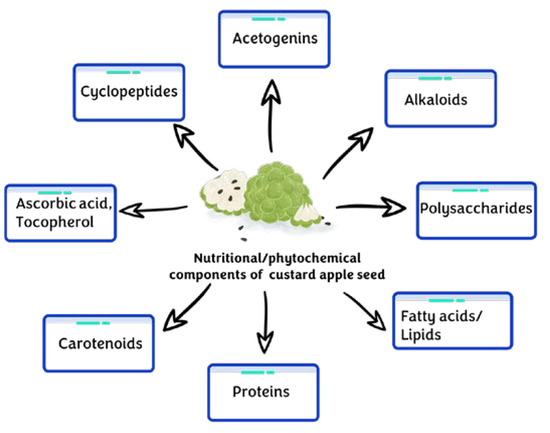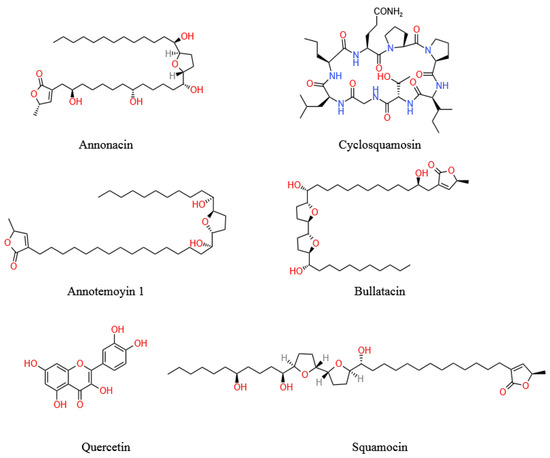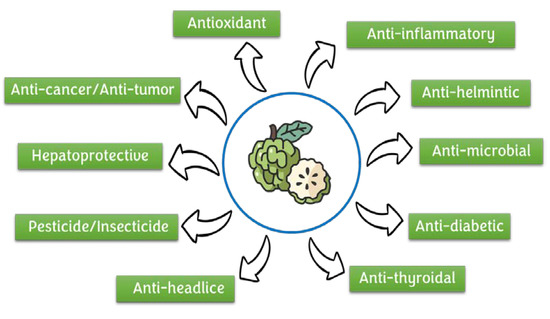Annona squamosa L. (custard apple or sugar apple), belonging to the Annonaceae family, is a small tree or shrub that grows natively in subtropical and tropical regions. Seeds of the custard apple have been employed in folk medicines because of the presence of bioactive chemicals/compounds such as alkaloids, flavonoids and phenolic compounds and acetogenins and cyclopeptides that are responsible for various biological activities. The seeds also show the presence of tannins, vitamin C, vitamin E and a higher content of amino acids. From investigations, it has been shown that the seeds of A. squamosa have considerable potential to be used as an antibacterial, hepatoprotective, antioxidant and antitumor/anticancer agent. Cyclosquamosin B, extracted from the custard apple seed, possesses vasorelaxant properties. Tocopherols and fatty acids, notably oleic acid and linoleic acid, are also found in the seed oil. A. squamosa seeds contain a high amount of annonaceous acetogenins compounds, which are potent mitochondrial complex I inhibitors and have high cytotoxicity. A survey primarily based on the nutritional, phytochemical and biological properties showed that A. squamosa seeds can be used for the discovery of novel products, including pharmaceutical drugs.
- custard apple seed
- health benefits
- bioactivities
- phytochemistry
- anticancer
1. Introduction

2. Proximate Composition of Custard Apple Seeds
|
Variety |
Category |
Compound |
Yield/Concentration |
Ref. |
|---|---|---|---|---|
|
Annona squamosa seeds |
Fatty acids (%) |
Margaric acid |
0.2 |
[21] |
|
Linoleic acid |
22.9 |
|||
|
Eicosanoic acid |
0.9 |
|||
|
Palmitic acid |
12.1 |
|||
|
Heneicosanoic acid |
2.3 |
|||
|
Stearic acid |
13.6 |
|||
|
Oleic acid |
47.4 |
|||
|
11-eicosanoic acid |
0.2 |
|||
|
Dihydrosterculic acid |
0.1 |
|||
|
17-Methyloctadecanoic acid |
0.1 |
|||
|
Palmitoleic acid |
0.01 |
|||
|
Annona squamosa seeds |
Amino acids (g/100 g protein) |
Leucine |
0.845 |
[22] |
|
Isoleucine |
0.464 |
|||
|
Glutamic acid |
0.995 |
|||
|
Phenylalanine + Tyrosine |
0.671 |
|||
|
Aspartic acid |
0.684 |
|||
|
Serine |
0.299 |
|||
|
Alanine |
0.594 |
|||
|
Methionine + Cystine |
0.106 |
|||
|
Histidine |
0.139 |
|||
|
Arginine |
0.704 |
|||
|
Glycine |
0.392 |
|||
|
Valine |
0.642 |
|||
|
Threonine |
0.324 |
|||
|
Lysine |
0.407 |
|||
|
Annona squamosa seeds |
Polysaccharides |
Rhamnose, Fucose, Mannose, Fructose, Arabinose, Galactose, Fructosamine, Galactosamine, Xylose, Glucose, Glucosamine, and Mannuronic, Alluronic, Glucuronic and Galacturonic acid |
USP = 0.67–1.27%; FSP = 2.82–3.72% |
[27] |
|
Annona squamosa seeds |
Carbohydrates (g/100 g DW (%)) |
- |
66.64 |
[23] |
|
Fat (g/100 g DW (%)) |
- |
29.21 |
||
|
Fiber (g/100 g DW (%)) |
- |
32.64 |
||
|
Ash (g/100 g DW (%)) |
- |
1.90 |
||
|
Protein (g/100 g DW (%)) |
- |
2.25 |
||
|
Moisture (g/100 g DW (%)) |
- |
3.92 |
||
|
Minerals (mg/kg) |
K |
56.47–355.84 |
||
|
Ca |
46.90–187.12 |
|||
|
P |
33.30–32.75 |
|||
|
Mg |
16.22–20.36 |
|||
|
Fe |
6.74–20.84 |
|||
|
Cu |
0.30–23.91 |
|||
|
Na |
9.29–28.27 |
|||
|
Zn |
0.43–22.17 |
|||
|
Mn |
0.25 |
|||
|
Annona squamosa seeds |
Crude protein (%) |
18.34 |
[28] |
|
|
Crude fiber (%) |
17.56 |
|||
|
Crude oil (%) |
30.41 |
|||
|
Total carbohydrates (%) |
21.80 |
|||
|
Moisture (%) |
6.65 |
|||
|
Ash (%) |
5.24 |
|||
|
Annona squamosa seeds |
Moisture (%) |
6.7 |
[22] |
|
|
Fat (%) |
26.8 |
|||
|
Protein (%) |
17.5 |
|||
|
Ash (%) |
2.2 |
|||
|
Fiber (%) |
16.8 |
|||
|
Tocopherol (mg/100 g) |
15.5–16.6 |
|||
|
Annona squamosa seeds |
Carotenoids (μg of β-Carotene/100 mg) |
0.45 |
[29] |
|
|
Vitamin C (mg AA/100 g) |
0.57 |
|||
DW—dry weight; FSP—fermented seed polysaccharide; USP—unfermented seed polysaccharide.
3. Phytochemical Profile of Custard Apple Seeds


4. Pharmacological Properties

|
Variety/Region |
Activity |
Extract/Solvent Used/Concentration |
Study/Cell Line/Animal Model |
Key Finding |
Ref. |
|---|---|---|---|---|---|
|
Annona squamosa seeds (Thiruvananthapuram, Kerala state) |
Antimicrobial |
Chloroform extract of seeds (10–60 μg/mL) |
E. coli, S. typhi, K. pnemoniae, P. mirabilis, B. subtilis, S. aureus |
Significant antibacterial activity with inhibition rate of 37–56, 40–60.75, 36–64, 48.5–63, 35–53.5 and 34–47% for K. pneumoniae, B. subtilis, E. coli, P. mirabilis, S. typhi and S. aureus |
[45] |
|
Annona squamosa seeds (Nashik, Maharashtra) |
Antimicrobial |
Petroleum ether, methanol and chloroform seed extract |
E. coli, P. aeruginosa, S. aureus, K. pneumoniae, B. subtilis |
PEE: highest growth inhibition rate was observed for S. aureus (ZOI: 12 mm) and lowest for P. aeruginosa with (ZOI 7.8 mm); ME: significant inhibition against K. pneumoniae (ZOI: 12.8 mm) and B. subtilis (ZOI: 9.2 mm); CE: inhibition against E. coli (ZOI: 14.8 mm) and B. subtilis (ZOI: 1.7 mm) |
[46] |
|
Annona squamosa seeds (Jayanagar, Bangalore) |
Antimicrobial |
Methanolic seed extract (50 mg/mL) |
E. coli, S. typhi, S. aeurus, E. faecalis, P. aeruginosa, S. paratyphi, K. pneumoniae |
Inhibits growth of bacterial strains with ZOI equal to 27–30 mm for E. coli, 31 mm for S. typhi, 27–32 mm for S. aeurus, 23 mm for E. faecalis, 22–24 mm for P. aeruginosa, 22–30 mm for S. paratyphi, 11–20 mm for K. pneumoniae |
[47] |
|
Annona squamosa seeds (Bangalore) |
Antimicrobial |
Methanolic seed extracts of A. squamosa and Prunus Persia (1:2) |
S. aureus, E. coli, K. pneumoniae, S. typhi, Enterococcus faecalis, P. aeruginosa, S. paratyphi |
ZOI ranges between 18–34 mm for all tested pathogens |
[48] |
|
Annona squamosa seeds (Alexandria, Egypt) |
Antimicrobial |
- |
E. coli, C. albicans, B. subtilis, K. pneumoniae, S. senftenberg, S. aureus |
ZOI ranging between 9.50, 9.53, 10.33, 12.30 6.50 and 12.50 mm against E. coli, C. albicans, K. pneumoniae, S. senftenberg, S. aureus and B. subtilis, respectively |
[23] |
|
Annona squamosa seeds |
Antimicrobial |
Aqueous seed extract (500 and 1000 mg pm- CuO NPs) |
Xanthomonas oryzae |
At 500 mg: ZOI = 9 mm; at 1000 mg: ZOI = 15 mm |
[49] |
|
Annona squamosa seeds (Nam Dinh, Vietnam) |
Antifungal |
Acetogenins (squamostatin-A (7), squamocin-G (5), and squamocin (8)) extracted from custard apple seeds |
Phytophthora infestans |
Acetogenins exhibit dose-dependent activity against the growth of zoospore and sporangium IC50 value for inhibition of sporangium germination was 1.24–2.09 μg/mL and IC50 value for zoospore germination inhibition was 1.89–3.05 μg/mL, for all acetogenins |
[81] |
|
Annona squamosa seeds |
Antidiabetic |
Ethanolic and methanolic seed extract (200 mg/kg BW) |
Alloxan-induced diabetic rats |
Decrease in level of blood glucose after administration of ethanolic seed extract (139.8–142 mg/dL) and methanolic seed extract (139–146 mg/dL) at 7th day of treatment |
[52] |
|
Annona squamosa seeds |
Anti-inflammatory |
Cyclopeptides-met-cherimolacyclopeptide and cyclosquamosin D (A1), and B (B) |
LPS-J774A.1 cell line |
Reduction in IL-6 and TNF-α secretion in J774A with an IC50 value of 1.22 and 9.2 µM |
[56] |
|
Annona squamosa seeds (Luye, Taitung County, Taiwan) |
Anti-inflammatory |
Cyclosquamosin D |
Lipopolysaccharide and Pam3Cys-stimulated J774A.1 macrophages |
Inhibition of secretion of pro-inflammatory cytokines |
[57] |
|
Annona squamosa seeds (Jiangsu, China) |
Antitumor |
Bullatacin and 12,15-cis-squamostatin-A |
A-549, Hela, HepG2 and MCF-7 (in vitro) and H22 tumor cell line in mice (in vivo) |
IC50 value for MCF-7, A-549, and HepG2 and Hela, are 2.5 × 10−1, 3.2, 3.6 × 10−1 and 13.0 µg/mL, respectively, and 69.55% inhibition of H22 cell line |
[18] |
|
Annona squamosa seeds (Jiangsu, China) |
Antitumor |
Seed oil |
H22 tumor cell line (mice: in vivo) |
Inhibition of growth of H22 cell line with maximum inhibitory rate of 53.54% |
[62] |
|
Annona squamosa seeds (TaiDong County, Taiwan) |
Antitumor |
Squadiolins A and B and squafosacin B |
MDA-MB-231, Hep G2, MCF-7 and Hep 3B, cell lines |
Squadiolins A- MDA-MB-231: IC50 = 0.63 µM; squadiolins B- MDA-MB-231: IC50 = 0.28 µM; squafosacin B- HepG2: IC50 = 0.71 µM; Hep 3B: IC50 = 0.72 µM; MCF-7: IC50 = 0.96 µM |
[63] |
|
Annona squamosa seeds (Hyderabad, India) |
Antitumor |
Aqueous and organic extract from defatted seeds |
AK-5 histiocytic tumor cell line in rat animal model |
Significant tumor cell apoptosis, with increased caspase-3 expression, down regulation of Bcl-2 and Bclxl antiapoptotic genes |
[11] |
|
Annona squamosa seeds (Beijing, China) |
Anticancer |
Seed oil nanoparticles |
4T1-Mouse breast cancer cells |
Inhibitory rate of 69.8% against 4T1 cell line |
[64] |
|
Annona squamosa seeds |
Anticancer |
Ethanolic seed extract |
MCF-7 breast cancer cell line |
Inhibit growth of MCF-7 (IC50 = 10 ug/mL) by inducing apoptosis |
[82] |
|
Annona squamosa seeds (Alexandria, Egypt) |
Anticancer |
- |
HepG-2, MCF-7, Caco-2 and PC-3 cancer cell lines |
Caco-2: IC50 = 11.55 μg/mL; HepG-2: IC50 = 7.99 μg/mL; MCF-7: IC50 = 14.34 μg/mL; PC-3: IC50 = 7.31 μg/mL |
[23] |
|
Annona squamosa seeds (Ahmedabad, India) |
Antioxidant |
Hexane, acetone, chloroform: methanol (2:1), ethanol (50%) and water seed extract |
DPPH assay |
Highest antioxidant activity was observed in water (777.64 g GAE/g), while lowest was observed in hexane (268.75 g GAE/g) seed extract |
[69] |
|
Annona squamosa seeds (Alexandria, Egypt) |
Antioxidant |
- |
DPPH assay |
IC50 value equal to 7.88 µg/mL |
[23] |
|
Annona squamosa seeds (Ceara, Brazil) |
Antioxidant |
Methanolic seed extract |
Fe3+ reduction, DPPH and ABTS assay |
IC50 value of 0.57, 0.36, and 0.14 mg/mL for Fe3+ reduction, DPPH and ABTS assay performed on methanolic seed extract, respectively |
[29] |
|
Annona squamosa seeds (Southeastern Brazil) |
Antioxidant |
Ethanolic seed extract |
DPPH assay |
EC50 value of seed extract is 63.19 µg/mL |
[70] |
|
Annona squamosa seeds (Lucknow, India) |
Antioxidant |
Ethanolic seed extract |
Alcohol-induced liver damage in Sprague Dawley rats (150–210 g) (dose: 200 and 400 mg/kg po) |
Significant elevation in the level of SOD, GSH and CAT and decrease in the level of TBARS |
[32] |
|
Annona squamosa seeds (Lucknow, India) |
Hepatoprotective |
Ethanolic seed extract |
Alcohol-induced liver injury in Sprague Dawley rats (150–210 g) (dose: 200 and 400 mg/kg po) |
Reduction in ALT, ALP, AST, LDH and SBL and cholesterol level and increase in the level of albumin (p < 0.01–p < 0.001) and total protein (p < 0.05–p < 0.001) |
[32] |
|
Annona squamosa seeds (Bangalore, India) |
Hepatoprotective |
Hydroalcoholic seed extract |
CCl4-induced hepatotoxicity in rats |
Reduction in the level of SGOT (51.22–87.37 U/L), SGPT (38.21–96.22 U/L), ALP (98.28–159.25 U/L) and total bilirubin (0.71–1.47 mg/dL) |
[20] |
|
Annona squamosa seeds (Mumbai, India) |
Antipsoriatic/antiproliferative |
Seed oil |
HaCaT cell line in Oxazolone-induced psoriasis in female Balb/C |
Inhibition of growth of HaCaT cells |
[19] |
|
Annona squamosa seeds (Madhya Pradesh, India) |
Antithyroidal |
Methanolic seed extract (dose: 200 mg/kg) |
L-T4 (0.5 mg/kg/day) caused hyperthyroid in rats |
After treating T4-induced hyperthyroid mice with seed extract (200 mg/kg) for 10 days, the effects of L-T4 were reversed, demonstrating the potential of custard apple seed in controlling hyperthyroidism |
[83] |
|
Annona squamosa seeds |
Vasorelaxant |
Cyclosquamosin B |
Rat animal model |
Inhibitory effect on Ca2+ channel, at concentration of 10−5 M |
[77] |
|
Annona squamosa seeds |
Antiheadlice |
Petroleum ether seed extract |
In vitro |
Petroleum ether extract along with coconut oil (1:1), kills 90% of lice |
[78] |
|
Annona squamosa seeds (Pak Chong, Thailand) |
Antiheadlice |
Hexane seed extract |
In vitro against headlice |
Seed extract contains oleic acid and a triglyceride with one oleate ester that kills lice in 11–49 min |
[84] |
|
Annona squamosa seeds |
Antihelminthic |
- |
- |
Seed extract exhibit antihelminthic activity against Pheritima posthuman and Haemonchus contortus |
[79] |
|
Annona squamosa seeds (Fortaleza, Brazil) |
Antihelminthic |
Ethyl acetate seed extract |
Haemonchus contortus |
C37 trihydroxy adjacent bis- tetrahydrofuran acetogenin repressed egg hatching of H. contortus at 25 mg mL−1 |
[85] |
|
Annona squamosa seeds |
Antilarval |
Crude ethanolic seed extract |
- |
Inhibit larval growth (20-fold) in Spodptera litura |
[80] |
|
Annona squamosa seeds (Thrissur, Kerala, India) |
Larvicidal activity |
Silver nanoparticles (AgNPs) of aqueous seed extract |
III and IV instars of Anopheles stephensi |
At 60 μg/mL, 100% mortality at III instar is observed. LC50 = 22.44 μg/mL; LC90 = 40.65 μg/mL at III instar stage. At IV instar LC50 = 27.83 μg/mL; LC90 = 48.92 μg/mL |
[86] |
|
Annona squamosa seeds (Thrissur, Kerala, India) |
Antibacterial |
Silver nanoparticles (AgNPs) of aqueous seed extract |
Staphylococcus aureus, Klebsiella pnuemoniae |
Antibacterial activity of AgNPs was found to be efficient compared with plant extract and commercial antibiotic tetracycline |
ZOI—zone of inhibition; PEE—petroleum ether extract; ME—methanolic extract; CE—chloroform extract; LPS—lipopolysaccharide stimulated; DPPH—2,2-diphenyl-1-picrylhydrazyl; ABTS—2,2-azinobis (3-ethylbenzothiazoline-6-sulfonic acid) (ABTS).
This entry is adapted from the peer-reviewed paper 10.3390/pr10102119
